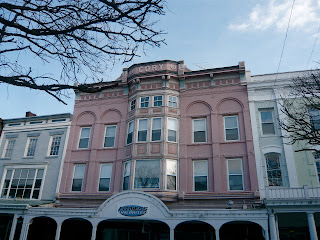 During a blizzard...
During a blizzard... and a few hours later.
and a few hours later. The sun melted the last snow very quickly but the cold temps remain. It's a lot easier to hike around in cold temps than when it's hot and humid. During the dog days of summer I walk mostly in towns.
I walk while the cats nap
 Kingston has loads of interesting shops -especially if you like books, music, art supplies & toys.
Kingston has loads of interesting shops -especially if you like books, music, art supplies & toys.  Kingston is pretty amazing. It was the first a capitol of New York, so it has a lot of grand places.
Kingston is pretty amazing. It was the first a capitol of New York, so it has a lot of grand places. Plenty of places to eat, there are coffee shops, diners, cafes, tea rooms and chocolate shops.
Plenty of places to eat, there are coffee shops, diners, cafes, tea rooms and chocolate shops. Something for everyone.
Something for everyone. And the architecture is fun too. Kingston has many very walkable neighborhoods and shopping areas.
And the architecture is fun too. Kingston has many very walkable neighborhoods and shopping areas.
 On Friday we enjoyed the sunshine at Kingston Point Beach. A beach in winter is a favorite outing for us.
On Friday we enjoyed the sunshine at Kingston Point Beach. A beach in winter is a favorite outing for us.  Mathilda is now an exhibit at the maritime museum. She was built in Quebec in 1898, and spent many years working in Montreal Harbor and New York Harbor-- she was the oldest steam tug in operation (in the States) when she retired to Kingston in 1969.
Mathilda is now an exhibit at the maritime museum. She was built in Quebec in 1898, and spent many years working in Montreal Harbor and New York Harbor-- she was the oldest steam tug in operation (in the States) when she retired to Kingston in 1969.  Icebreakers in the distance. This is the Roundout Creek -- a tributary of the Hudson River. It was nearly 50 degrees on Friday, so it was a day of melting, and we enjoyed an extra extra long walk.
Icebreakers in the distance. This is the Roundout Creek -- a tributary of the Hudson River. It was nearly 50 degrees on Friday, so it was a day of melting, and we enjoyed an extra extra long walk. A close up of the snowy beach.
A close up of the snowy beach.
 Saturday was a cold day in The Catskills, but it was time to log.
Saturday was a cold day in The Catskills, but it was time to log.  Every so many decades the loggers are called in ~ for stewardship of the land and for a little pocket money to help pay for saplings to plant in warmer weather.
Every so many decades the loggers are called in ~ for stewardship of the land and for a little pocket money to help pay for saplings to plant in warmer weather.  This logging road has been here since the 1700's when people from Connecticut owned parcels and called the area "Lumberland." This road leads to a parcel of a few hundred acres of forest.
This logging road has been here since the 1700's when people from Connecticut owned parcels and called the area "Lumberland." This road leads to a parcel of a few hundred acres of forest. Most of the dense forest is above the logging road on ridges, or below in a valley. The loggers will be busy for awhile, and when they complete the task of clearing away so much dead wood (you wouldn't believe how many trees fall in a thirty year period) and chopping a few select trees, there will still be plenty of trees in the forest, and room for more to grow in a healthy environment.
Most of the dense forest is above the logging road on ridges, or below in a valley. The loggers will be busy for awhile, and when they complete the task of clearing away so much dead wood (you wouldn't believe how many trees fall in a thirty year period) and chopping a few select trees, there will still be plenty of trees in the forest, and room for more to grow in a healthy environment.